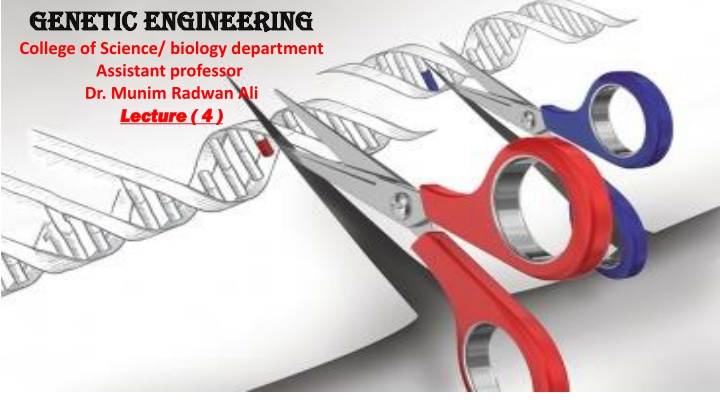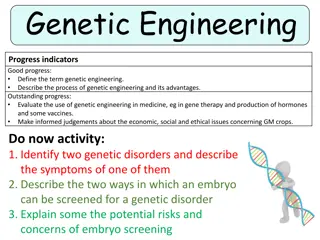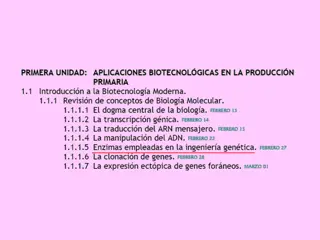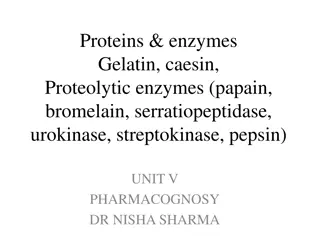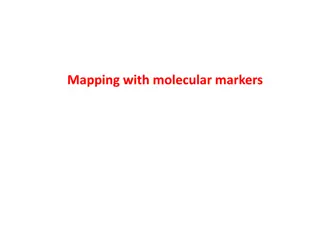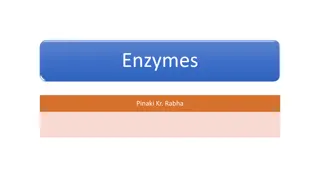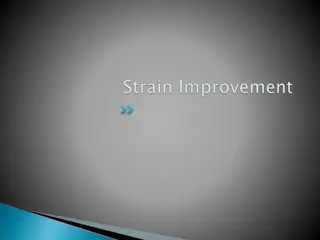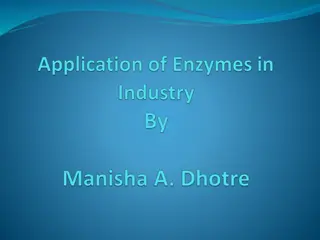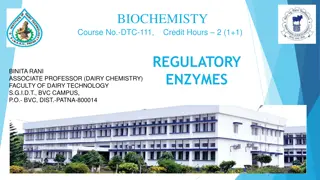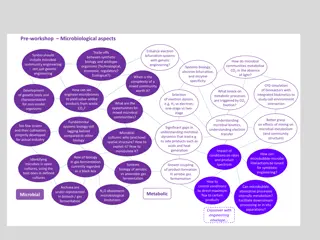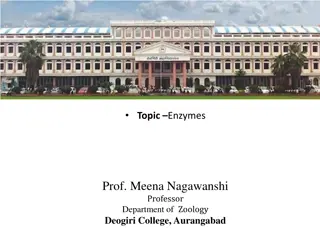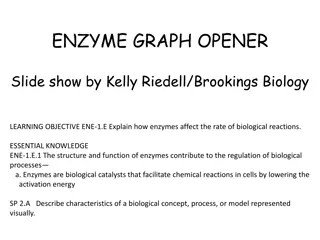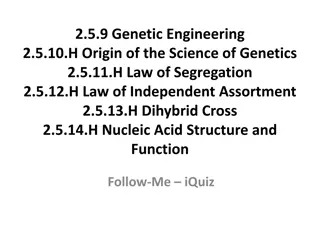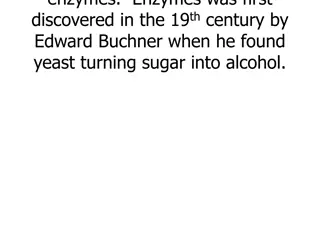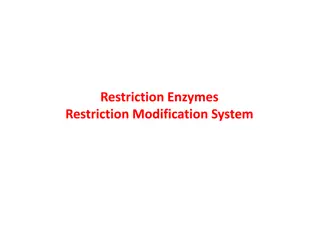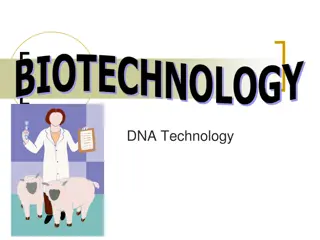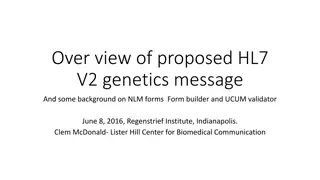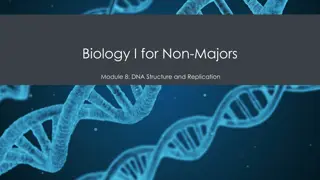Insights into Enzymes in Genetic Engineering
Discover the role of enzymes like Polynucleotide Phosphorylase, Deoxyribonuclease, and Phosphatase in genetic engineering processes. Learn how these enzymes regulate mRNA processing, DNA cleavage, and phosphate group cleavage, crucial for various applications in biotechnology.
Download Presentation

Please find below an Image/Link to download the presentation.
The content on the website is provided AS IS for your information and personal use only. It may not be sold, licensed, or shared on other websites without obtaining consent from the author.If you encounter any issues during the download, it is possible that the publisher has removed the file from their server.
You are allowed to download the files provided on this website for personal or commercial use, subject to the condition that they are used lawfully. All files are the property of their respective owners.
The content on the website is provided AS IS for your information and personal use only. It may not be sold, licensed, or shared on other websites without obtaining consent from the author.
E N D
Presentation Transcript
GENETIC ENGINEERING GENETIC ENGINEERING College of Science/ biology department Assistant professor Dr. Munim Radwan Ali Lecture ( Lecture ( 4 4 ) )
ENZYMES IN GENETIC ENGINEERING Polynucleotide Phosphorylase was first discovered from extracts of Azotobacter agile by Grunberg-Mango and Ochoa It is bifunctional enzyme in RNA processing and degradation inside the cell `This enzyme can catalyze not only the synthesis of RNA from the mixtures of naturally occurring ribonucleoside diphosphates, but also that of non-naturally occurring polyribonucleotides. In rDNA cloning technology, it has been used to synthesize radiolabelled polyribonucleotides from nucleoside diphosphate monomers.
In E.coli , polynucleotide phosphorylase regulates mRNA processing either by adding ribonucleotides to the 3' end or by cleaving bases in 3' to 5' direction. The function of PNPase depends upon inorganic phosphate (Pi) concentration inside the cell. The transcripts are polyadenylated using enzyme polyadenylate polymerase I (PAPI). After primary polyadenylylation of the transcript by PAP I, PNPase may bind to the 3 end of the poly(A) tail. PNPase works either degradatively or biosynthetically inside the cell depending on the Pi concentration. Under high Pi concentration, it degrades the poly(A) tail releasing adenine diphosphates. If the Pi concentration is low, PAP I initiates addition of one or more nucleotides to the existing poly (A) tail and in the process generates inorganic phosphate. On dissociation of PNPase, the 3 end again is available to PAP I for further polymerization.
Deoxyribonuclease (Dnase : ( A nuclease enzyme that can catalyze the hydrolytic cleavage of phosphodiester bonds in the DNA backbone are known as deoxyribonuclease (Dnase(. Based on the position of action, these enzymes are broadly classified as endodeoxyribonuclease (cleave DNA sequence internally) and exodeoxyribonuclease (cleave the terminal nucleotides). Unlike restriction enzymes, DNase does not have any specific recognition/restriction site and cleave DNA sequence at random locations.
Phosphatase: Phosphatase catalyses the cleavage of a phosphate (PO4-2) group from substrate by using a water molecule (hydrolytic cleavage). This reaction is not reversible. . On the basis of their activity there are two types of phosphatase i.e acid phosphatase and alkaline phosphatase. In both forms the alkaline phosphatase are most common. Special class of phosphatase that remove a phosphate group from protein, called Phosphoprotein phosphatase . Fig: Schematicrepresentation of hydrolytic cleavageof phosphategroup(PO4-2).
Methylase: Methyltransferase or methylase catalyzes the transfer of methyl group (-CH3) to its substrate. The process of transfer of methyl group to its substrate is called methylation. Methylation is a common phenomenon in DNA and protein structure. Methyltransferase uses a reactive methyl group that is bound to sulfur in S-adenosyl methionine (SAM) which acts as the methyl donor. Methylation normally occurs on cytosine (C) residue in DNA sequence. In protein, methylation occurs on nitrogen atom either on N-terminus or on the side chain of protein. DNA methylation regulates gene or silence gene without changing DNA sequences, as a part of epigenetic regulation. In bacterial system, methylation plays a major role in preventing their genome from degradation by restriction enzymes. It is a part of restriction modification system in bacteria.
Methyltransferase can be classified in threegroups: a)m6A-generates N6methyladenosine, b) m4C-generates N4methylcytosine, c)m5C-generatesN5methylcytosine. m6A and responsible for methylation of DNA sequences in order to prevent the host from digesting its own genome via its restrictionenzyme. m4C prokaryotes. These enzymes are
Ligases: DNA ligase catalyses the formation of phosphodiester bond between two deoxynucleotide residues of two DNAstrands. DNA ligase enzyme requires a free hydroxyl group at the 3 -end of one DNA chain and a phosphate group at the 5 -end of the other and requires energy in the process. The role of DNA ligase is to seal nicks in the backbone of double-stranded DNA after lagging strand formation to join the okazaki fragments. This joining process is essential for the normal synthesis of DNA and for repairing damaged DNA. It has been exploited by genetic engineers to join DNA chains to form recombinant DNA molecules. Usually single stranded break are repaired using the complimentary strand as thetemplate but sometimes double stranded breaks can also be repaired with the help of DNA ligase. The most widely used DNA ligase is isolated from T4 bacteriophage
Application: DNA ligase enzyme is used by cells to join the okazaki fragments during DNA replication process. In molecular cloning, ligase enzyme has been routinely used to construct a recombinant DNA. Followings are some of the examples of application of ligase enzyme in molecular cloning. Joining of adapters and linkers to blunt end DNAmolecule. Cloning of restricted DNA to vector to construct recombinant vector.
Polynucleotide Kinase: PNK is a homotetramer with phosphatase activity at 3' end and kinase activity at 5' end with a tunnel like active site. The active site has side chains which interact with NTP donor's beta-phosphate and 3' phosphate of acceptor with an acid which activated 5' OH. Lys-15 and Ser-16 are important for the kinase activity of the enzyme. The basic residues of active site of PNK interact with the negatively charged phosphates of the DNA. Polynucleotide kinase (PNK) catalyzes the transfer of a phosphate group (PO4-2) from position of ATP to the 5' end of either DNA or RNA and nucleoside monophosphate . PNK can convert 3' PO4 /5' OH ends into 3' PO4 /5' PO4 ends which blocks further ligation by ligase enzyme. PNK is used to label the ends of DNA or RNA with radioactive phosphate group. T4 polynucleotide kinase is the most widely used PNK in molecular cloning experiments, which was isolated from T4 bacteriophage infected E.coli .
Ribonuclease (RNase(: Nuclease that can catalyze hydrolysis of ribonucleotides from either single stranded or double stranded RNAsequence are calledribonucleotides (RNase(. RNase are classified into two types depending on position of cleavage, i.e. endoribonuclease (cleave internal bond) and exoribonuclease (cleaveterminal bond(. RNaseisimportant for RNAmaturation andprocessing. RNaseAandRNaseH playimportant role in initial defencemechanism against RNAviral infection.
